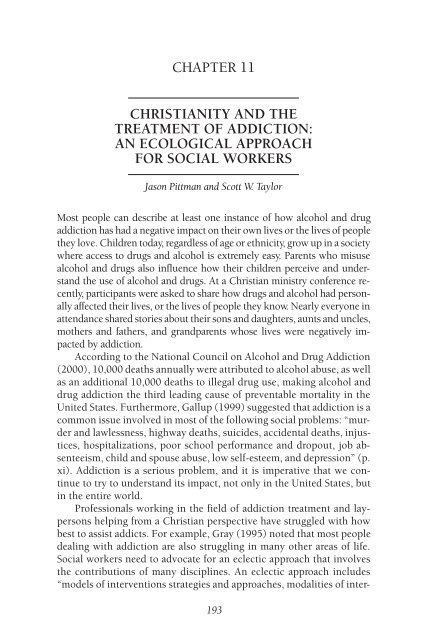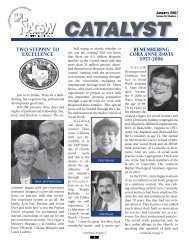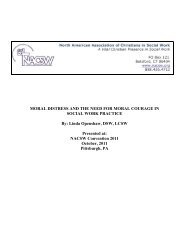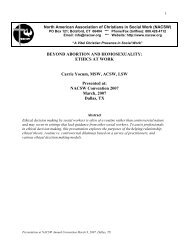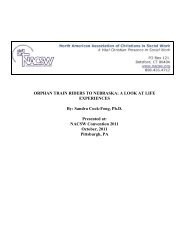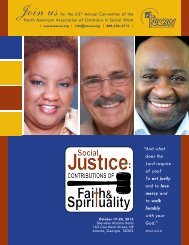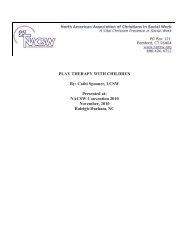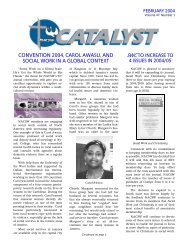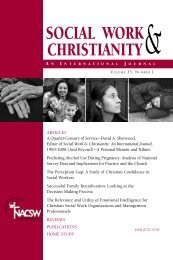christianity and the treatment of addiction - North American ...
christianity and the treatment of addiction - North American ...
christianity and the treatment of addiction - North American ...
- No tags were found...
Create successful ePaper yourself
Turn your PDF publications into a flip-book with our unique Google optimized e-Paper software.
CHAPTER 11CHRISTIANITY AND THETREATMENT OF ADDICTION:AN ECOLOGICAL APPROACHFOR SOCIAL WORKERSJason Pittman <strong>and</strong> Scott W. TaylorMost people can describe at least one instance <strong>of</strong> how alcohol <strong>and</strong> drug<strong>addiction</strong> has had a negative impact on <strong>the</strong>ir own lives or <strong>the</strong> lives <strong>of</strong> people<strong>the</strong>y love. Children today, regardless <strong>of</strong> age or ethnicity, grow up in a societywhere access to drugs <strong>and</strong> alcohol is extremely easy. Parents who misusealcohol <strong>and</strong> drugs also influence how <strong>the</strong>ir children perceive <strong>and</strong> underst<strong>and</strong><strong>the</strong> use <strong>of</strong> alcohol <strong>and</strong> drugs. At a Christian ministry conference recently,participants were asked to share how drugs <strong>and</strong> alcohol had personallyaffected <strong>the</strong>ir lives, or <strong>the</strong> lives <strong>of</strong> people <strong>the</strong>y know. Nearly everyone inattendance shared stories about <strong>the</strong>ir sons <strong>and</strong> daughters, aunts <strong>and</strong> uncles,mo<strong>the</strong>rs <strong>and</strong> fa<strong>the</strong>rs, <strong>and</strong> gr<strong>and</strong>parents whose lives were negatively impactedby <strong>addiction</strong>.According to <strong>the</strong> National Council on Alcohol <strong>and</strong> Drug Addiction(2000), 10,000 deaths annually were attributed to alcohol abuse, as wellas an additional 10,000 deaths to illegal drug use, making alcohol <strong>and</strong>drug <strong>addiction</strong> <strong>the</strong> third leading cause <strong>of</strong> preventable mortality in <strong>the</strong>United States. Fur<strong>the</strong>rmore, Gallup (1999) suggested that <strong>addiction</strong> is acommon issue involved in most <strong>of</strong> <strong>the</strong> following social problems: “murder<strong>and</strong> lawlessness, highway deaths, suicides, accidental deaths, injustices,hospitalizations, poor school performance <strong>and</strong> dropout, job absenteeism,child <strong>and</strong> spouse abuse, low self-esteem, <strong>and</strong> depression” (p.xi). Addiction is a serious problem, <strong>and</strong> it is imperative that we continueto try to underst<strong>and</strong> its impact, not only in <strong>the</strong> United States, butin <strong>the</strong> entire world.Pr<strong>of</strong>essionals working in <strong>the</strong> field <strong>of</strong> <strong>addiction</strong> <strong>treatment</strong> <strong>and</strong> laypersonshelping from a Christian perspective have struggled with howbest to assist addicts. For example, Gray (1995) noted that most peopledealing with <strong>addiction</strong> are also struggling in many o<strong>the</strong>r areas <strong>of</strong> life.Social workers need to advocate for an eclectic approach that involves<strong>the</strong> contributions <strong>of</strong> many disciplines. An eclectic approach includes“models <strong>of</strong> interventions strategies <strong>and</strong> approaches, modalities <strong>of</strong> inter-193
194 Jason Pittman <strong>and</strong> Scott W. Taylorvention, organized conceptualizations <strong>of</strong> client problems or <strong>of</strong> practice,sets <strong>of</strong> practice principles, practice wisdom, <strong>and</strong> even philosophies <strong>of</strong>practice” (Abbott, 2000, p. 27).This chapter attempts to provide insight into <strong>the</strong> main issues regardingan informed eclectic approach. In <strong>the</strong> first section, we discuss <strong>the</strong> generalfield <strong>of</strong> <strong>addiction</strong> <strong>treatment</strong>, define <strong>addiction</strong> for <strong>the</strong> purpose <strong>of</strong> this chapter,provide a summary <strong>of</strong> <strong>addiction</strong> etiology <strong>the</strong>ories, <strong>and</strong> discuss relevant<strong>treatment</strong> interventions. The second section is a discussion concerning <strong>the</strong>interaction <strong>of</strong> Christianity <strong>and</strong> <strong>addiction</strong> historically, with particular emphasison <strong>the</strong> contribution <strong>of</strong> pastoral <strong>the</strong>ology <strong>and</strong> Christian <strong>treatment</strong>programs. The chapter concludes by emphasizing that social workers shouldutilize an eclectic approach when helping addicts, while integrating <strong>the</strong>contributions <strong>of</strong> <strong>addiction</strong> etiology <strong>the</strong>ories <strong>and</strong> <strong>treatment</strong> interventions.Brief HistoryIn <strong>the</strong> United States, <strong>the</strong> nation’s first settlers had to deal with issuesrelated to drug <strong>and</strong> alcohol abuse. They drank more beer than water because<strong>of</strong> <strong>the</strong> lack <strong>of</strong> safe drinking water (Van Wormer, 1995). In <strong>the</strong> eighteenthcentury, distilled spirits became available to <strong>the</strong> masses <strong>and</strong> contributedto drunkenness at all class levels. People viewed alcohol <strong>and</strong> drug<strong>addiction</strong> as a moral problem, resulting from sinful behavior <strong>and</strong> moralweakness in <strong>the</strong> individual. Society treated addicts very poorly, <strong>and</strong> <strong>the</strong>yfaced condemnation, guilt, shame, <strong>and</strong> many times ostracism (Morgan, 1999,p. 4). The term “alcoholic” was first used by <strong>the</strong> Swedish physician MagnusHuss in 1849. He defined alcoholism as “<strong>the</strong> state <strong>of</strong> chronic alcohol intoxicationthat was characterized by severe physical pathology <strong>and</strong> disruption<strong>of</strong> social functioning” (White, 1998, p. xiv).Within <strong>the</strong> last hundred years, we have seen a major shift in howsociety perceives <strong>addiction</strong>. During <strong>the</strong> temperance <strong>and</strong> prohibitionmovements people tried to eliminate alcohol completely, believing thatif alcohol were illegal, <strong>the</strong>n <strong>addiction</strong> would cease to exist. Later, with<strong>the</strong> help <strong>of</strong> scientific research, <strong>the</strong> medical field began identifying <strong>addiction</strong>as a disease, considering <strong>the</strong> etiology to be strictly biological (VanWormer, 1995). It was during <strong>the</strong> early 1900s when Huss’s term “alcoholic”began to be circulated within pr<strong>of</strong>essional circles, <strong>and</strong> in <strong>the</strong> 1930’s,Alcoholics Anonymous (AA) launched <strong>the</strong> term into widespread use.By 1944, <strong>the</strong> U.S. Public Health Service identified <strong>addiction</strong> as <strong>the</strong> fourthlargest health concern in <strong>the</strong> nation (Strung, Priyadarsini, & Hyman, 1986).The pr<strong>of</strong>essional, medical, <strong>and</strong> research communities began to mobilize<strong>and</strong> to create <strong>the</strong> new field <strong>of</strong> <strong>addiction</strong> <strong>treatment</strong> through <strong>the</strong> following:work <strong>of</strong> pioneers like E.M. Jellinek <strong>and</strong> Mark Keller; organizations such as
Christianity <strong>and</strong> <strong>the</strong> Treatment <strong>of</strong> Addiction 195<strong>the</strong> National Committee for Education on Alcoholism, Research Councilon Problems <strong>of</strong> Alcohol; <strong>the</strong> Summer School <strong>of</strong> Alcohol Studies at Yale; <strong>and</strong>volunteers like Marty Mann <strong>and</strong> her National Council on Alcoholism (Morgan,1999; Royce, 1981; White, 1998). The first major step in shaping <strong>the</strong>field <strong>of</strong> <strong>addiction</strong> <strong>treatment</strong> <strong>and</strong> counseling occurred when <strong>the</strong> <strong>American</strong>Medical Association accepted <strong>the</strong> disease concept <strong>of</strong> alcoholism in 1956.One year later, <strong>the</strong> World Health Organization accepted <strong>the</strong> concept <strong>of</strong> alcoholismas a pathological condition.By 1960, society began debating how best to define alcoholism whileover 200 definitions circulated in various helping arenas (White, 1998).Pr<strong>of</strong>essionals began to include o<strong>the</strong>r drugs <strong>and</strong> behaviors besides alcoholin <strong>the</strong> field <strong>of</strong> <strong>addiction</strong>, causing <strong>the</strong> debates to continue through<strong>the</strong> end <strong>of</strong> <strong>the</strong> 20 th century. Today, <strong>the</strong> <strong>American</strong> Psychiatric Association(APA) uses <strong>the</strong> term “substance related disorders” to be inclusive <strong>of</strong> abroad range <strong>of</strong> problems associated with alcohol <strong>and</strong> drug usage (<strong>American</strong>Psychiatric Association, 2000). In this chapter, we will use <strong>the</strong> term<strong>addiction</strong> earlier defined by APA as <strong>the</strong> state <strong>of</strong> being “compulsively <strong>and</strong>physiologically dependent on a habit-forming substance” (McNeece &DiNitto, 1998, p. 23).Addiction Etiology TheoriesThe 1960s-1980s was a time <strong>of</strong> growing research <strong>and</strong> developmentconcerning <strong>addiction</strong> studies in <strong>the</strong> broad areas <strong>of</strong> psychology, psychiatry,<strong>and</strong> social work. Today, <strong>the</strong>re are a number <strong>of</strong> <strong>the</strong>ories to explain<strong>addiction</strong>, <strong>and</strong> <strong>the</strong>se <strong>the</strong>ories are as varied as <strong>the</strong> number <strong>of</strong> definitions<strong>of</strong> <strong>addiction</strong> (McNeece & DiNitto, 1998). We will provide a brief summary<strong>of</strong> <strong>the</strong> following broad areas <strong>of</strong> etiology <strong>the</strong>ory: moral, biological,psychological, sociocultural, <strong>and</strong> multi-causal.Historically, <strong>the</strong> moral <strong>the</strong>ory has described <strong>addiction</strong> as a result <strong>of</strong>“humankind’s sinful nature” (McNeece & DiNitto, 1998). Fingarette <strong>and</strong>Peele (as cited in McNeece & DiNitto) provide <strong>the</strong> contemporary equivalent<strong>of</strong> <strong>the</strong> moral <strong>the</strong>ory. These <strong>the</strong>orists, however, do not suggest that <strong>addiction</strong>is caused by sinful nature; instead, <strong>addiction</strong> is a result <strong>of</strong> bad choices.We place <strong>the</strong>se <strong>the</strong>orists in <strong>the</strong> moral model because <strong>the</strong>ir primary premiseis that <strong>addiction</strong> is cured by <strong>the</strong> simple choice <strong>of</strong> abstinence.Biological <strong>the</strong>ories assume addicts are “constitutionally predisposedto develop a dependence on alcohol or drugs” (McNeece & DiNitto,1998, p.27). These <strong>the</strong>ories emphasize <strong>the</strong> physiological sources <strong>of</strong> <strong>addiction</strong>such as genetics or neurochemistry. Genetic research is not suggestingthat people are genetically determined to be addicts. Instead, itpoints toward people as being predisposed to <strong>addiction</strong>. Neurochemis-
196 Jason Pittman <strong>and</strong> Scott W. Taylortry is divided into two <strong>the</strong>ories: brain dysfunction <strong>and</strong> brain chemistry.These <strong>the</strong>ories argue that biochemical changes taking place in addictsmay cause irreversible loss <strong>of</strong> control during <strong>the</strong> use <strong>of</strong> alcohol or drugs.Research suggests that certain people have <strong>the</strong> propensity to be unableto control <strong>the</strong>ir usage once <strong>the</strong>y start. This lack <strong>of</strong> control may be due toheredity or actual changes that occur within <strong>the</strong> body because <strong>of</strong> <strong>the</strong>drug interacting with <strong>the</strong> brain (Clinebell, 1990; Leshner, 2001).Psychological <strong>the</strong>ories include a broad range <strong>of</strong> <strong>the</strong>ories that havevery different outlooks on <strong>the</strong> cause <strong>of</strong> <strong>addiction</strong>. For example, cognitive-behavioral<strong>the</strong>ories suggest several reasons for addicts taking drugs:to experience variety, desire to experience pleasure, or avoidance <strong>of</strong> withdrawalsymptoms (McNeece & DiNitto, 1998). In addition, psychodynamic<strong>and</strong> personality <strong>the</strong>ories look to underlying personality issues,hoping to explain <strong>the</strong> causes <strong>of</strong> <strong>addiction</strong>. These explanations vary greatly<strong>and</strong> may consist <strong>of</strong> coping with painful experiences, guilt, loneliness,conflict, or low self-esteem (Clinebell, 1990).Sociocultural <strong>the</strong>ories emphasize <strong>the</strong> importance <strong>of</strong> social attitudestoward <strong>addiction</strong> <strong>and</strong> link those attitudes surrounding alcohol <strong>and</strong> drugsas being <strong>the</strong> cause <strong>of</strong> many people’s decision to start abusing drugs oralcohol (Ciarrocchi, 1993). Theorists categorize sociocultural <strong>the</strong>oriesinto three areas that focus on different environmental factors found insociety <strong>and</strong> culture (McNeece & DiNitto, 1998). For example, <strong>the</strong>oristsargue that European countries have a much lower rate <strong>of</strong> alcoholism ascompared to <strong>the</strong> U.S. because <strong>of</strong> <strong>the</strong>ir tolerant views on drinking <strong>and</strong>intolerant views on drunkenness.Addiction is a very complex disorder that affects all aspects <strong>of</strong> one’slife. Pr<strong>of</strong>essionals in <strong>the</strong> last sixty years have provided extensive research<strong>and</strong> literature in <strong>the</strong> field, attempting to explain <strong>the</strong> root causes <strong>of</strong> <strong>addiction</strong>.Unfortunately, research does not provide one simple cause <strong>of</strong><strong>addiction</strong>. Theorists, however, have proposed two models that attemptto include multiple etiology <strong>the</strong>ories <strong>of</strong> <strong>addiction</strong>. Pattison <strong>and</strong> Kaufman(as cited in McNeece & DiNitto, 1998) <strong>of</strong>fered a multivariate model in<strong>the</strong> early 1980s that encompassed a multitude <strong>of</strong> causes <strong>of</strong> <strong>addiction</strong>.Health care <strong>and</strong> human service pr<strong>of</strong>essionals, however, have advocatedfor <strong>the</strong> public health model. This model attempts to encompass manydifferent possible causes <strong>of</strong> <strong>addiction</strong> <strong>and</strong> involves looking at <strong>the</strong> interaction<strong>of</strong> <strong>the</strong> agent, host, <strong>and</strong> environment.Addiction Treatment InterventionsThere are a variety <strong>of</strong> interventions available to treat individualssuffering from <strong>addiction</strong>. For this chapter, intervention is conceptual-
Christianity <strong>and</strong> <strong>the</strong> Treatment <strong>of</strong> Addiction 197ized in three ways: self-help groups, pr<strong>of</strong>essional <strong>treatment</strong> programs,<strong>and</strong> counseling techniques. Alcoholic Anonymous (AA) is an example<strong>of</strong> a spiritual based self-help. They have attempted to bypass <strong>the</strong> problems<strong>of</strong> etiology <strong>and</strong> move into <strong>of</strong>fering to alcoholics <strong>and</strong> helpers a pragmaticprogram <strong>of</strong> recovery that is based on <strong>the</strong> person’s spiritual life <strong>and</strong>underst<strong>and</strong>ing <strong>of</strong> a higher power. Therefore, many people today mistakenlyrefer to AA as a <strong>treatment</strong> program instead <strong>of</strong> a self-help group.AA started in <strong>the</strong> 1930s by two alcoholics trying to help each o<strong>the</strong>r stopdrinking. It was one <strong>of</strong> <strong>the</strong> pioneering self-help groups <strong>and</strong> quickly becamea widespread movement. In addition, AA was instrumental in promoting<strong>the</strong> labeling <strong>of</strong> alcoholism as a disease. However, AA itself didnot advocate a strict disease model. It was simply a fellowship <strong>of</strong> peoplewith a common desire to stop using alcohol <strong>and</strong> drugs, <strong>and</strong> findingsobriety by “working” through a twelve-step program.As <strong>of</strong> January 2001, AA reported over 100,000 groups worldwidewith membership totaling over 2.1 million people (General Service Office,2001). Although one <strong>of</strong> <strong>the</strong> hallmarks <strong>of</strong> AA is non-pr<strong>of</strong>essional<strong>treatment</strong>, most pr<strong>of</strong>essional <strong>treatment</strong> centers have integrated AA’s ideasinto <strong>the</strong> core <strong>of</strong> <strong>the</strong>ir <strong>addiction</strong> <strong>treatment</strong> programs (Van Wormer, 1995).In fact, Brown, Peterson, <strong>and</strong> Cunningham (1988) reported 95% <strong>of</strong> U.S.<strong>treatment</strong> centers are requiring, or have access to, AA meetings in <strong>the</strong>ir<strong>treatment</strong> programs.Interventions can also include pr<strong>of</strong>essional <strong>treatment</strong> programs suchas outpatient or inpatient clinics or hospitals as well as long-term residentialfacilities. In <strong>the</strong> U.S., alcohol <strong>and</strong> drug <strong>treatment</strong> systems providedover 15,000 federal, state, local, <strong>and</strong> private programs that served760,721 clients in 1999 (Office <strong>of</strong> Applied Studies, 1999). The Minnesotamodel <strong>of</strong> <strong>treatment</strong>, introduced by <strong>the</strong> Hazelden Treatment Centerin Minnesota in <strong>the</strong> 1940s, combined AA’s twelve-steps with psychologicallybased group <strong>the</strong>rapy (Van Wormer, 1995). This model gainedpopularity in <strong>the</strong> 1970s <strong>and</strong> is <strong>the</strong> predominant model used in <strong>treatment</strong>centers today.There are a multitude <strong>of</strong> interventions available to clinicians treatingaddicts based on counseling techniques <strong>and</strong> <strong>the</strong>ories, many <strong>of</strong> whichare based on <strong>the</strong> etiology <strong>the</strong>ories discussed in <strong>the</strong> previous section.Similar to how researchers have proposed that one etiology <strong>the</strong>ory isnot sufficient, <strong>the</strong>y have also suggested that <strong>the</strong>re are strengths in many<strong>of</strong> <strong>the</strong> counseling interventions. In fact, Miller, et al. (1995) argued in<strong>the</strong>ir methodological analysis <strong>of</strong> outcome studies that “<strong>the</strong>re does notseem to be any one <strong>treatment</strong> approach adequate to <strong>the</strong> task <strong>of</strong> treatingall individuals with alcohol problems” (p. 32).
198 Jason Pittman <strong>and</strong> Scott W. TaylorTrans<strong>the</strong>oretical ModelProchaska, DiClemente, <strong>and</strong> Norcross (1992) began to study howpeople change in psycho<strong>the</strong>rapy. They realized that <strong>the</strong> hundreds <strong>of</strong>outcome studies did not <strong>of</strong>fer insight into <strong>the</strong> common principles thatwere allowing <strong>the</strong> change to occur. These researchers spent years analyzing<strong>and</strong> researching <strong>the</strong> processes that people go through when <strong>the</strong>ychange <strong>and</strong> <strong>the</strong> corresponding processes <strong>the</strong>rapists use to facilitate thatchange. They developed <strong>the</strong> Trans<strong>the</strong>oretical Model that consists <strong>of</strong> twoimportant interrelated <strong>the</strong>ories for practice: <strong>the</strong> stages <strong>of</strong> change <strong>and</strong><strong>the</strong> processes <strong>of</strong> change.In <strong>the</strong> first part, Prochaska, et al. (1992) suggested that <strong>the</strong> stages <strong>of</strong>change (see table 1.0) do not necessarily progress in a linear nature, butbecause <strong>of</strong> how common relapse is in <strong>addiction</strong>, addicts usually follow aspiral pattern <strong>of</strong> change. Abbott (2000) noted that, “not every one completes<strong>the</strong> cycle. Some recycle numerous times; o<strong>the</strong>rs stay in one or morestages <strong>of</strong> change, never exiting” (p. 117). Prochaska, et al. explained that“<strong>the</strong> stage <strong>of</strong> change scores were <strong>the</strong> best predictors <strong>of</strong> outcome; <strong>the</strong>y werebetter predictors than age, socioeconomic status, problem severity <strong>and</strong> duration,goals <strong>and</strong> expectations, self-efficacy, <strong>and</strong> social support” (p. 116).The Trans<strong>the</strong>oretical Model also stresses <strong>the</strong> importance <strong>of</strong> matching<strong>the</strong> processes <strong>of</strong> change to <strong>the</strong> stage <strong>of</strong> change. Prochaska, et al. (1992)noted that past <strong>addiction</strong> <strong>treatment</strong>’s poor success rates were in part dueto <strong>treatment</strong> centers not having tailored <strong>the</strong>ir <strong>the</strong>rapeutic approach tomatch <strong>the</strong> clients’ stage <strong>of</strong> change (see table 1.0). Abbott (2000) suggestedthat when <strong>the</strong> social worker is choosing a process <strong>of</strong> change <strong>and</strong>accompanying methods <strong>and</strong> techniques, it is best to consider <strong>the</strong> client’s“age, personality characteristics, cultural factors, lifestyle, previous experienceswith <strong>the</strong>rapy, <strong>the</strong> severity <strong>of</strong> <strong>the</strong> ATOD [alcohol, tobacco, o<strong>the</strong>rdrugs] problem, <strong>and</strong> available environmental resources” (p. 120).Christian Approaches to Etiology <strong>and</strong> InterventionThis section explores <strong>the</strong> development <strong>of</strong> Christian approaches to etiology<strong>and</strong> <strong>treatment</strong> <strong>of</strong> <strong>addiction</strong>. We will also highlight <strong>the</strong> significance <strong>of</strong>Christianity in <strong>the</strong> development <strong>of</strong> Alcoholic Anonymous. Christianity hasstruggled with <strong>the</strong> topic <strong>of</strong> <strong>addiction</strong>, because it has historically characterized<strong>addiction</strong> as simply a sinful choice. This has created barriers betweenChristians attempting to provide a <strong>the</strong>ological contribution to <strong>the</strong> field <strong>of</strong><strong>addiction</strong> <strong>treatment</strong> <strong>and</strong> <strong>the</strong> secular community.In <strong>the</strong> late 1800s, a religious experience was viewed as <strong>the</strong> antidotefor <strong>addiction</strong> (White, 1998). Many addicts were proclaiming that
Christianity <strong>and</strong> <strong>the</strong> Treatment <strong>of</strong> Addiction 199Table 1 1Stages <strong>of</strong> Change in Which Particular Change Processes are Most UsefulStages <strong>of</strong> ChangePrecontemplation Contemplation Preparation Action MaintenanceConsciousness raisingSocial liberationProcesses <strong>of</strong> ChangeEmotional arousalSelf-reevaluationCommitmentRewardCounteringEnvironmental controlHelping relationships1 Source: Table 1 from Changing for Good (1994) by James O. Prochaska, John C.Norcross <strong>and</strong> Carlo C. Diclemente. Reprinted by permission <strong>of</strong> Harper Collins PublishersInc.God took away <strong>the</strong>ir <strong>addiction</strong> in religious revivals. These revivalsprovided entrance for addicts into o<strong>the</strong>r social groups such as lodges,churches, tent meetings, missions, <strong>and</strong> informal helping resources. Theemergence <strong>of</strong> an urban society significantly contributed to <strong>the</strong> increasein <strong>the</strong> numbers <strong>of</strong> Christian approaches to alcoholism recovery. Theareas in cities where vagrants <strong>and</strong> destitute alcoholics made <strong>the</strong>ir homeswere labeled “Skid Rows” (p. 72). These areas were becoming majorproblems for civic leaders, <strong>and</strong> chronic <strong>addiction</strong> was seen as <strong>the</strong> primaryproblem.In 1826, David Nasmith started a rescue mission in Glasgow, Scotl<strong>and</strong>.The name “rescue mission” implied that <strong>the</strong> organization wouldrescue persons from “Skid Rows” by providing temporary shelter, food,<strong>and</strong> o<strong>the</strong>r assistance. Jerry McAuley <strong>and</strong> Samuel Hadley started similarrescue missions in <strong>the</strong> U.S. to address <strong>the</strong> problems associated with <strong>addiction</strong><strong>and</strong> “Skid Rows” (White, 1998). These pioneers were heavily influencedby protestant evangelists who preached that <strong>addiction</strong> was a sin<strong>and</strong> emphasized <strong>the</strong> conversion experience as <strong>the</strong> cure for <strong>addiction</strong>. By<strong>the</strong> early 1900s, <strong>the</strong> rescue mission movement had spread to most <strong>of</strong> <strong>the</strong>major cities in <strong>the</strong> U.S. (Bakke, 1995). Currently, <strong>the</strong>re are almost 200rescue missions in <strong>the</strong> U.S. that have <strong>treatment</strong> programs.Salvation Army became <strong>the</strong> most extensive urban Christian approach
200 Jason Pittman <strong>and</strong> Scott W. Taylorin helping addicts (White, 1998). William Booth started Salvation Armyin 1865 in London, Engl<strong>and</strong>, <strong>and</strong> <strong>the</strong> organization exp<strong>and</strong>ed to <strong>the</strong> U.S.in 1880. Booth attracted addicts by providing <strong>the</strong>m with food <strong>and</strong> shelter<strong>and</strong> suggested that <strong>the</strong> cure for <strong>addiction</strong> would involve “Christiansalvation <strong>and</strong> moral education in a wholesome environment” (White,p. 74). By 1900, Salvation Army had spread to over 700 U.S. cities. Today,Salvation Army has 152 centers in <strong>the</strong> U.S. serving over 15,000addicts annually (Peters, 1980; Salvation Army, 2002).The early 20 th century also saw an emergence <strong>of</strong> pr<strong>of</strong>essional viewson religion <strong>and</strong> <strong>addiction</strong> recovery. In 1902, William James, a Harvardpsychologist <strong>and</strong> medical doctor, wrote The Varieties <strong>of</strong> Religious Experiences(White, 1998). This book explored <strong>the</strong> role <strong>of</strong> religious conversionas <strong>the</strong> cure for <strong>addiction</strong>, describing religious transformation asbeing ei<strong>the</strong>r a sudden or a gradual process. James wrote about <strong>the</strong> powerthat conversion has on removing <strong>the</strong> cravings for alcohol <strong>and</strong> providinga new perspective or outlook for <strong>the</strong> addict’s life. These ideas highlyinfluenced <strong>the</strong> later developments <strong>of</strong> AA.Ano<strong>the</strong>r example <strong>of</strong> a Christian presence in <strong>the</strong> <strong>addiction</strong> field wasseen when <strong>the</strong> Emmanuel Church Clinic in Boston opened in 1906 for<strong>the</strong> <strong>treatment</strong> <strong>of</strong> various psychological disorders (White, 1998). Theseearly clinicians attempted to integrate religion, medicine, <strong>and</strong> psychologyin <strong>the</strong>ir <strong>treatment</strong> for <strong>addiction</strong>. This program was quite differentfrom Salvation Army or rescue missions. Emmanuel’s <strong>treatment</strong> was <strong>the</strong>first to focus on psychologically based group <strong>and</strong> individual counseling.White suggested that this program “foreshadows <strong>the</strong> current use <strong>of</strong>spirituality in <strong>addiction</strong> <strong>treatment</strong>” (p. 100). Their use <strong>of</strong> self-inventory<strong>and</strong> confession was influential in <strong>the</strong> development <strong>of</strong> <strong>the</strong> Oxford Group,a Christian evangelical group, <strong>and</strong> later AA. The Emmanuel clinic discontinuedits <strong>treatment</strong> program after <strong>the</strong> death <strong>of</strong> one <strong>of</strong> <strong>the</strong> primaryfounders, Rev. Dr. Elwood Worcester, in <strong>the</strong> 1940s.Alcoholics Anonymous is one <strong>of</strong> <strong>the</strong> most influential approachesrooted in Christianity. AA does not align itself with any religious group,church, or organization, it underst<strong>and</strong>s <strong>addiction</strong> to have biological,psychological, <strong>and</strong> social influences, but primarily <strong>of</strong>fers a spiritual approachto recovery (Hester & Miller, 1995). Christian concepts, however,are inherent in AA’s twelve-steps, <strong>and</strong> <strong>the</strong>se concepts have had alarge impact on <strong>the</strong> development <strong>of</strong> various twelve-step programs.The founders <strong>of</strong> AA, Bill Wilson <strong>and</strong> Dr. Bob Smith, began as members<strong>of</strong> <strong>the</strong> Oxford Group (White, 1998). The Oxford Group movement beganon college campuses in Engl<strong>and</strong> <strong>and</strong> spread quickly in <strong>the</strong> U.S. Clinebell(1998) suggested “it was an attempt to bring vital, first-century Christianityinto <strong>the</strong> lives <strong>of</strong> people, challenging <strong>the</strong>m to live by certain ethical abso-
Christianity <strong>and</strong> <strong>the</strong> Treatment <strong>of</strong> Addiction 201lutes <strong>and</strong> motivating <strong>the</strong>m to change o<strong>the</strong>rs” (p. 273). The Oxford Groupused six steps to accomplish this purpose. In 1939, Wilson <strong>and</strong> “Dr. Bob”took <strong>the</strong> ideas from <strong>the</strong>se six steps <strong>and</strong> adapted <strong>the</strong>m specifically to <strong>the</strong>needs <strong>of</strong> alcoholics, <strong>the</strong>reby, creating <strong>the</strong> twelve-steps <strong>of</strong> AA.The idea <strong>of</strong> AA’s Twelve-Steps is that alcoholics cannot overcome<strong>addiction</strong> on <strong>the</strong>ir own. They must turn <strong>the</strong>ir lives over to a higherpower <strong>and</strong> seek a spiritual path to recovery as <strong>the</strong> only way to gaincontrol <strong>of</strong> <strong>the</strong>ir <strong>addiction</strong> (Hester & Miller, 1995). It is important tonote that <strong>the</strong> Twelve-Steps are not a requirement for AA membership;<strong>the</strong>y are <strong>the</strong> steps <strong>the</strong> founding AA members took to obtain <strong>and</strong> maintainsobriety <strong>and</strong> are “suggested as a program <strong>of</strong> recovery” In addition,AA stresses that <strong>the</strong>se principles are primarily “guides to progress” <strong>and</strong>members “claim spiritual progress ra<strong>the</strong>r than spiritual perfection” (AlcoholicsAnonymous, pp.59- 60).Step one suggests that alcoholics should admit <strong>the</strong>y are “powerlessover alcohol – that [<strong>the</strong>ir] lives had become unmanageable.” Step twobegins <strong>the</strong> process <strong>of</strong> believing that a Higher Power can help <strong>the</strong>m, whileStep three suggests <strong>the</strong>y need to make a “decision to turn [<strong>the</strong>ir] will<strong>and</strong> [<strong>the</strong>ir] lives over to <strong>the</strong> care <strong>of</strong> God as [<strong>the</strong>y] underst<strong>and</strong> Him.” InStep four, alcoholics make a “searching <strong>and</strong> fearless moral inventory <strong>of</strong>[<strong>the</strong>mselves]” (Alcoholics Anonymous, p. 58). Then, Step five suggeststhat alcoholics should admit to “God, to <strong>the</strong>mselves <strong>and</strong> to ano<strong>the</strong>rhuman being <strong>the</strong> exact nature <strong>of</strong> <strong>the</strong>ir wrongs.” Step six asks alcoholicsto be ready for God to help <strong>the</strong>m with <strong>the</strong>ir character defects, <strong>and</strong> Stepseven encourages alcoholics to ask “Him to remove [<strong>the</strong>ir] shortcomings.”In Step eight, alcoholics make “a list <strong>of</strong> all persons we had harmed,<strong>and</strong> become willing to make amends to <strong>the</strong>m all” (Alcoholics Anonymous,pp. 58-59). Subsequently, Step nine encourages members to makeamends with those people.The final three maintenance steps provide suggestions for alcoholics tomaintain sobriety. Step ten requires alcoholics to be continually responsiblefor <strong>the</strong>ir negative behavior <strong>and</strong> promptly admit when <strong>the</strong>y are wrong. Stepeleven emphasizes that alcoholics must continue in spiritual growth throughprayer <strong>and</strong> meditation with <strong>the</strong> goal <strong>of</strong> being knowledgeable <strong>of</strong> God’s willfor <strong>the</strong>ir lives <strong>and</strong> <strong>the</strong> “power to carry that [will] out.” Finally, in Step twelve,once alcoholics have completed <strong>the</strong> o<strong>the</strong>r steps <strong>and</strong> have had a “spiritualawakening,” <strong>the</strong>y are encouraged to help o<strong>the</strong>r alcoholics through that sameprocess (Alcoholics Anonymous, pp. 58-60).When Wilson <strong>and</strong> “Dr. Bob” created <strong>the</strong> twelve steps, <strong>the</strong>y purposelyavoided any direct reference to Jesus Christ, <strong>and</strong> this omission upsetmany Christians (Hardin, 1994). They thought that <strong>the</strong> anonymity <strong>of</strong>God in <strong>the</strong> twelve steps was strategically important. This generic form
202 Jason Pittman <strong>and</strong> Scott W. Taylor<strong>of</strong> spirituality <strong>and</strong> <strong>the</strong> traditions <strong>of</strong> AA have kept it from being an organizedreligion. However, it is important to note that both AA <strong>and</strong> organizedreligions share a “moral <strong>and</strong> transcendent perspective; an emphasison repentance; ultimate dependence <strong>and</strong> conversion experience; scriptures<strong>and</strong> a creed; rituals; <strong>and</strong> a communal life” (Peteet, 1993, p. 263-267). Christians should not let <strong>the</strong> lack <strong>of</strong> direct references deter <strong>the</strong>mfrom utilizing AA.The success <strong>and</strong> rapid growth <strong>of</strong> AA had an effect on <strong>the</strong> development<strong>of</strong> Salvation Army’s <strong>addiction</strong> <strong>treatment</strong> programs. By <strong>the</strong> 1940s, SalvationArmy began to separate <strong>the</strong>ir <strong>addiction</strong> <strong>treatment</strong> centers from <strong>the</strong>ir homelessshelters (White, 1998). They changed <strong>the</strong>ir programs in order to include“a broadening approach to treating alcoholism that integrated medicalassistance, pr<strong>of</strong>essional counseling, Alcoholics Anonymous, <strong>and</strong> ChristianSalvation” (White, p. 75). Salvation Army <strong>of</strong>ficers were also involvedin <strong>the</strong> initial Summer School <strong>of</strong> Alcohol Studies at Yale University, <strong>and</strong>, by<strong>the</strong> 1950s, Salvation Army was hiring social workers to help implement amore pr<strong>of</strong>essional structured <strong>the</strong>rapy program.Rescue missions <strong>and</strong> Salvation Army historically have received <strong>the</strong>most criticism for <strong>the</strong>ir moralistic views on <strong>addiction</strong>, viewing that addictsjust need to “get saved” (Clinebell, 1998). As described above,however, Salvation Army has attempted to integrate clinical models witha Christian perspective. Fur<strong>the</strong>rmore, research has shown that SalvationArmy has comparable success rates to o<strong>the</strong>r secular <strong>treatment</strong> centers(Bromet, Moos, Wuthmann, & Bliss, 1977; Gauntlett, 1991; Katz,1966; Moss, 1996; Zlotnick & Agnew, 1997).In recent years, rescue missions have also begun to integrate clinicalmodels with <strong>the</strong>ir Christian perspective. Rescue missions, overall, still emphasizeChristian conversion as <strong>the</strong> primary solution to recovery more th<strong>and</strong>oes <strong>the</strong> Salvation Army. Additionally, Salvation Army primarily uses AAwhile <strong>the</strong> association <strong>of</strong> rescue missions is a sponsor <strong>of</strong> Alcoholics Victorious,a network <strong>of</strong> explicitly Christian twelve-step support groups. Unfortunately,little research has been conducted on <strong>the</strong> evaluation or <strong>treatment</strong>approach <strong>of</strong> rescue missions (See Fagan, 1986).In 1958, David Wilkerson, a Pentecostal preacher, started Teen Challenge,a more explicitly Christian salvific approach to <strong>addiction</strong> <strong>treatment</strong>.In his book, The Cross <strong>and</strong> <strong>the</strong> Switchblade, Wilkerson shares hisexperiences in ministering to <strong>the</strong> youth <strong>and</strong> <strong>the</strong> gangs in New York City.Teen Challenge views <strong>addiction</strong> as primarily an issue <strong>of</strong> sin, <strong>and</strong> <strong>the</strong>solution is a conversion experience where <strong>the</strong> person is “‘born again’ byaccepting Jesus Christ as ‘personal Savior’” (Muffler, Langrod, & Larson,1997, p. 587). Teen Challenge currently operates 120 centers in <strong>the</strong>U.S. <strong>and</strong> 250 centers worldwide for its 12 to 18 month residential pro-
Christianity <strong>and</strong> <strong>the</strong> Treatment <strong>of</strong> Addiction 203gram (Teen Challenge, 2000). Ironically, only six Teen Challenge centersserve teenagers. Many programs also have changed <strong>the</strong>ir name tobe more inclusive for all ages (e.g., Life Challenge in Dallas, TX). Interestingly,Muffler, Langrod, & Larson (1997) argued that <strong>the</strong> rates <strong>of</strong>success for Teen Challenge have been grossly over stated; instead <strong>of</strong>86%, <strong>the</strong>y suggest that success rates are closer to 18.3%, similar to <strong>the</strong>15% success rates <strong>of</strong> secular <strong>the</strong>rapeutic communities.O<strong>the</strong>r arenas <strong>of</strong> Christian <strong>treatment</strong> have developed over <strong>the</strong> years.Saint Marr’s Clinic in Chicago, <strong>the</strong> Christian Reformed Church’s AddictsRehabilitation Center in New York, Episcopal Astoria ConsultationService in New York, <strong>and</strong> East Harlem Protestant Parish’s ExodusHouse (White, 1998) are some examples. Muffler, et al. (1997) notedthat Protestants <strong>and</strong> Catholics address <strong>addiction</strong> at <strong>the</strong> denominationalor diocesan level through organizations like Catholic Charities orLu<strong>the</strong>ran Social Services. Also, <strong>the</strong>re are Christian <strong>treatment</strong> programslocated within hospital settings (e.g., Rapha) or outpatient clinics (e.g.,New Life Clinics or Minirth Myer Clinics) designed for individuals withinsurance or o<strong>the</strong>r means to pay for <strong>treatment</strong>.In addition, <strong>the</strong>re are thous<strong>and</strong>s <strong>of</strong> smaller Christian <strong>treatment</strong> programsthroughout <strong>the</strong> U.S. In <strong>the</strong> state <strong>of</strong> Texas, for example, <strong>of</strong> <strong>the</strong> approximately115 registered faith-based providers, <strong>the</strong> larger Christian organizationsmentioned in <strong>the</strong> paragraph above account for fewer than ten<strong>of</strong> <strong>the</strong> providers. The majority <strong>of</strong> <strong>the</strong> remaining organizations are localChristian <strong>treatment</strong> facilities. Fur<strong>the</strong>rmore, <strong>the</strong> Christians in Recovery’s(2002) database contains over 2500 Christian ministries, organizations,local groups <strong>and</strong> meetings worldwide that deal with <strong>addiction</strong>. The SubstanceAbuse <strong>and</strong> Mental Health Services Administration, a governmentagency, does not track faith-based or Christian programs in <strong>the</strong>ir database<strong>of</strong> over 15,000 <strong>treatment</strong> facilities. In fact, <strong>the</strong>y claimed it was difficult toeven define faith-based programs because a facility may be funded by areligious organization, but not have inherently religious teachings (L.Henderson, personal communication, April 15, 2002).Pastoral Theology’s ContributionChristian approaches to <strong>addiction</strong> <strong>treatment</strong> vary based on <strong>the</strong>ir<strong>the</strong>ological interpretation <strong>of</strong> Biblical passages. Fur<strong>the</strong>rmore, a dichotomyin <strong>addiction</strong> <strong>treatment</strong> developed based on those particular <strong>the</strong>ologicalapproaches to <strong>addiction</strong>. Some approaches have focused on <strong>addiction</strong>simply as sin, <strong>and</strong> “getting saved” was <strong>the</strong> primary solution. O<strong>the</strong>r groupstook a more liberal approach to <strong>addiction</strong> as some <strong>the</strong>ologians werebeginning to shift <strong>the</strong>ir thoughts to what <strong>the</strong> Bible says about human
204 Jason Pittman <strong>and</strong> Scott W. Taylornature, our relationship with God, <strong>and</strong> God’s purpose for our lives <strong>and</strong>applying it to <strong>addiction</strong> <strong>treatment</strong>. A full historical account <strong>of</strong> <strong>the</strong> development<strong>of</strong> pastoral <strong>the</strong>ology’s contribution to <strong>the</strong> <strong>addiction</strong> <strong>treatment</strong>field is not within <strong>the</strong> scope <strong>of</strong> this section. However, a brief historicalsummary is provided with particular emphasis on several <strong>the</strong>ologians’contributions to <strong>the</strong> underst<strong>and</strong>ing <strong>of</strong> <strong>addiction</strong>.Protestant pastoral <strong>the</strong>ology began in <strong>the</strong> 1800s in Germany, but<strong>the</strong> <strong>American</strong> pastoral <strong>the</strong>ology movement, which focused more on <strong>the</strong>psychology <strong>of</strong> religion, emerged in <strong>the</strong> 1930s with pioneers such as AntonBoisen, Richard Cabot, <strong>and</strong> Russell Dicks (Burck & Hunter, 1990). Theyprovided insight into <strong>the</strong> relationship between religion <strong>and</strong> health <strong>and</strong>contributed a large amount <strong>of</strong> literature concerning psychological pastoralcare <strong>and</strong> counseling to <strong>the</strong> field. These pioneers drew from <strong>the</strong>work <strong>of</strong> Paul Tillich <strong>and</strong> o<strong>the</strong>r neo-orthodox <strong>the</strong>ologians.Clinebell’s (1998) textbook presented his pastoral approach to <strong>addiction</strong>.Originally published in 1956, it was <strong>the</strong> first major work on<strong>addiction</strong> by a pastoral <strong>the</strong>ologian. Clinebell (1994) argued that religiousfactors rooted in <strong>the</strong> addicts’ h<strong>and</strong>ling <strong>of</strong> existential anxiety arecrucial to underst<strong>and</strong>ing both <strong>the</strong> etiology <strong>and</strong> <strong>the</strong> <strong>treatment</strong> <strong>of</strong> <strong>addiction</strong>.He suggested that addicts are trying to “satisfy religious needs by anonreligious means—alcohol” (p. 267). A Christian holistic view <strong>of</strong><strong>addiction</strong>, from a pastoral <strong>the</strong>ological view, does not suggest that peopleare “sinful because <strong>the</strong>y are addicted… ra<strong>the</strong>r, disharmonious existenceis a state <strong>of</strong> being indigenous to <strong>the</strong> human condition <strong>and</strong> requires interventionby a power greater than ourselves” (Morgan, 1998, p. 27).One can trace this <strong>the</strong>ology back to existential philosophers <strong>and</strong><strong>the</strong>ologians such as Heidegger, Kierkergaard, Tillich, <strong>and</strong> Moore (Morgan& Jordan, 1999). Existentialism is primarily concerned with questionsregarding <strong>the</strong> meaning <strong>and</strong> value <strong>of</strong> human life (Evans, 1984).Existentialists argue that all humans are finite beings, <strong>and</strong> we all experience“a sense <strong>of</strong> limits, restlessness, <strong>and</strong> estrangement” (Morgan & Jordan,p. 265). Tillich (1991) described estrangement as separation fromGod <strong>and</strong> said it was a part <strong>of</strong> our “essential nature” (p. 187).Clinebell (1998) applied this <strong>the</strong>ology to underst<strong>and</strong>ing <strong>addiction</strong><strong>and</strong> argued that this estrangement causes us to have anxiety, <strong>and</strong> weseek to soo<strong>the</strong> our anxiety in inappropriate ways. Hunter (1990) suggestedthat this anxiety leads to inner conflict that cuts <strong>of</strong>f <strong>the</strong> personfrom growth <strong>and</strong> development. This experience <strong>of</strong> aloneness <strong>and</strong> feelingisolated, not just from o<strong>the</strong>rs, but also from self, makes us vulnerableto <strong>addiction</strong>. Clinebell (1998) wrote that as we begin to crave <strong>the</strong>“anxiety-deadening effects” <strong>of</strong> drugs <strong>and</strong> alcohol we are attempting tosoo<strong>the</strong> <strong>the</strong> anxiety through artificial means (p. 30).
Christianity <strong>and</strong> <strong>the</strong> Treatment <strong>of</strong> Addiction 205It is important to underst<strong>and</strong> that dealing with issues <strong>of</strong> meaning<strong>and</strong> <strong>the</strong> finite nature <strong>of</strong> human life is basic to everyone. We all strugglewith who we are psychologically <strong>and</strong> spiritually (Morgan & Jordan,1999). For addicts, coping takes <strong>the</strong> form <strong>of</strong> <strong>addiction</strong> <strong>and</strong> has <strong>the</strong> psychologicalfunction to “compensate for missing or inadequately developedpsychological functions <strong>of</strong> self-care, self-soothing, <strong>and</strong> self-regulation”(Hopson & Moses, 1996, p.10). Temporarily, this form <strong>of</strong> copingwill suffice to numb <strong>the</strong> anxiety. Eventually, however, it is not enoughto stop <strong>the</strong> deep psychological <strong>and</strong> spiritual need for meaning <strong>and</strong> purpose.In fact, as addicts continue to use drugs <strong>and</strong> alcohol, life becomeseven more meaningless, hopeless, <strong>and</strong> spiritually empty (Clinebell,1998). The <strong>American</strong> Psychiatric Association (as cited by Miller, 1998)described <strong>addiction</strong> as “a phenomenon that slowly takes over a person’slife, displacing all else” (p. 34). Addicts position alcohol <strong>and</strong> drugs in<strong>the</strong> place <strong>of</strong> God, attempting to fill <strong>the</strong> void <strong>of</strong> estrangement. The <strong>the</strong>ologicalterm for this process is idolatry (Romans 1; Isaiah 42:8).Surrender <strong>and</strong> SanctificationContinuing with pastoral <strong>the</strong>ology’s contributions to <strong>the</strong> <strong>addiction</strong>field, we take <strong>the</strong> next step to see how confronting <strong>the</strong> idolatry helps in<strong>the</strong> recovery process. Addicts begin to deal with <strong>the</strong> idolatry in <strong>the</strong>irlives when <strong>the</strong>y confront <strong>and</strong> deal with <strong>the</strong>ir existential anxiety (i.e.,<strong>the</strong> void <strong>of</strong> not knowing what <strong>the</strong> purpose in life is). As <strong>the</strong>y begin toask for help, a Christian spirituality can <strong>of</strong>fer addicts a “nonchemicalmeans” <strong>of</strong> soothing <strong>the</strong>ir anxiety (Clinebell, 1998, p. 283). This process<strong>of</strong> spirituality begins with surrendering, a process that addicts go throughwhen <strong>the</strong>y begin to realize <strong>the</strong>y cannot control <strong>the</strong>ir <strong>addiction</strong>. AA identifiesthis process as “hitting bottom.” It may occur during differentpoints in life for each addict, <strong>and</strong> <strong>the</strong> common thread between addicts isa realization that <strong>the</strong>y have lost <strong>the</strong>ir freedom in <strong>addiction</strong>, realizingthat alcohol <strong>and</strong> drugs are not God.Christians have a rich <strong>the</strong>ological history from which <strong>the</strong>y can drawideas relating to this idea <strong>of</strong> surrender. Saint Augustine, an early <strong>the</strong>ologian,wrote that until <strong>the</strong> human heart rests in God, <strong>the</strong> restlessness inour lives would not cease (Morgan & Jordan, 1999). Writing about humanpursuit <strong>of</strong> happiness <strong>and</strong> <strong>the</strong> need to soo<strong>the</strong> <strong>the</strong> anxiety, Augustineargued that people would only find emptiness until <strong>the</strong>y come to a place<strong>of</strong> surrender, allowing God to fill <strong>the</strong> void that only God can fill. Augustineemphasized <strong>the</strong> bondage <strong>of</strong> <strong>the</strong> will by describing it as “<strong>the</strong> force <strong>of</strong>habit, by which <strong>the</strong> mind is swept along <strong>and</strong> held fast even against itswill” (Stone & Clements, 1991, p. 260).
206 Jason Pittman <strong>and</strong> Scott W. TaylorDietrich Bonhoeffer (1995), a twentieth century <strong>the</strong>ologian, wrotethat <strong>the</strong> first step for maturing Christians is to cut <strong>of</strong>f ties from <strong>the</strong>previous life. He added that single-minded obedience is how God callspeople in <strong>the</strong> Scripture; one only needs to deny oneself in order to be adisciple <strong>of</strong> Christ. Jurgon Motlmann (1999), a contemporary <strong>the</strong>ologian,said that when Christians deny <strong>the</strong>mselves, <strong>the</strong>y become weak,but it is in this weakness where <strong>the</strong>y will find <strong>the</strong>ir strength. As <strong>the</strong>ysurrender, <strong>the</strong>y find meaning <strong>and</strong> purpose in God.Albers (1997) described <strong>the</strong> process <strong>of</strong> surrender as “experienced,but never totally explained; accepted for what it is, but never totallyaccounted for; observable, but not objectively definable in conventionalscientific categories” (p. 25). Interestingly enough, secular scientists havesome underst<strong>and</strong>ing <strong>and</strong> appreciation <strong>of</strong> this process. Tiebout, a pioneerpsychiatrist in <strong>the</strong> field <strong>of</strong> <strong>addiction</strong>, looked at this process <strong>of</strong> conversionin alcoholics involved in AA <strong>and</strong> concluded that surrender <strong>and</strong><strong>the</strong> process <strong>of</strong> spiritual transformation is <strong>the</strong> key to change for addicts(Tiebout, 1951; 1994).Let it be noted that surrender is not an instantaneous event thatcures <strong>addiction</strong>. Addicts may not be seeking to soo<strong>the</strong> <strong>the</strong> anxiety withdrugs, but addicts are still “addict(s) in <strong>the</strong> <strong>the</strong>rapeutic sense” (Limeta,1993, p. 40). In many ways, this is when <strong>the</strong> difficult work begins; Christian<strong>the</strong>ology terms this process sanctification. Once addicts surrender<strong>and</strong> begin a relationship with <strong>the</strong> divine, <strong>the</strong> process <strong>of</strong> sanctificationassists <strong>the</strong> believers as <strong>the</strong>y seek to mature in <strong>the</strong>ir faith.Discussion <strong>of</strong> Theories <strong>and</strong> Treatment InterventionsMcNeece <strong>and</strong> DiNitto (1998) noted, “a significant advance in <strong>the</strong>study <strong>of</strong> <strong>addiction</strong> is <strong>the</strong> realization that it is probably not a unitarydisease” (p. 32). However, practitioners may become very dogmatic in<strong>the</strong>ir application <strong>of</strong> one <strong>the</strong>ory for all types <strong>of</strong> cases. This approach <strong>of</strong>taking from only one <strong>the</strong>ory is not supported by <strong>the</strong> literature, <strong>and</strong> <strong>the</strong>refore,it has <strong>the</strong> possibility <strong>of</strong> not providing <strong>the</strong> best <strong>treatment</strong>. Abbott(2000) warned that <strong>the</strong> wrong use <strong>of</strong> <strong>the</strong>ory in social work practicecould lead to ineffective <strong>treatment</strong> for clients.The National Association <strong>of</strong> Social Workers (as cited in Abbott, 2000)suggested that social workers should take into consideration that “social,economic, <strong>and</strong> environmental factors contribute to alcohol, tobacco,<strong>and</strong> o<strong>the</strong>r drug abuse ” (p. xi). Goodman (1995), a psychiatrist, wrotethat one <strong>of</strong> <strong>the</strong> problems in <strong>addiction</strong> <strong>treatment</strong> is that it encompassesbiological, behavioral, social-interpersonal, <strong>and</strong> psychodynamic issues;<strong>and</strong> most <strong>treatment</strong> providers are only trained in one or two <strong>of</strong> those
Christianity <strong>and</strong> <strong>the</strong> Treatment <strong>of</strong> Addiction 207areas. Social workers are trained in all <strong>of</strong> <strong>the</strong>se areas <strong>and</strong> bring valuableskills <strong>and</strong> education to <strong>the</strong> <strong>addiction</strong> <strong>treatment</strong> field.Van Wormer (1995) noted that <strong>the</strong> ecological framework provides <strong>the</strong>best paradigm in capturing <strong>the</strong> complexities <strong>of</strong> <strong>addiction</strong> <strong>and</strong> <strong>of</strong>fers assistancewhen conceptualizing <strong>and</strong> treating <strong>addiction</strong>. A major advantage <strong>of</strong><strong>the</strong> ecological framework is that “it can subsume within its framework o<strong>the</strong>r<strong>the</strong>oretical models <strong>and</strong> <strong>treatment</strong> orientations. There is not an ei<strong>the</strong>r-orwith this formulation – viewing <strong>the</strong> person in <strong>the</strong> situation includes <strong>the</strong>total biopsychosocial reality” (Van Wormer, 1995, p. 18). Social workersneed to appreciate <strong>the</strong> contributions each <strong>of</strong> <strong>the</strong> etiological <strong>the</strong>ories <strong>of</strong> <strong>addiction</strong>provides to underst<strong>and</strong>ing <strong>the</strong> problem, while realizing that onlyone model is insufficient for total recovery.The Trans<strong>the</strong>oretical Model, a good example <strong>of</strong> an ecological model, isone <strong>of</strong> <strong>the</strong> most promising <strong>and</strong> helpful research <strong>and</strong> practice tools in <strong>the</strong><strong>addiction</strong> field. Dunn (2000) suggested that social workers should adoptthis model for <strong>addiction</strong> <strong>treatment</strong> not only because <strong>of</strong> <strong>the</strong> strong empiricalresearch supporting it, but also for its “compatibility with <strong>the</strong> mission, values,<strong>and</strong> problem solving orientation <strong>of</strong> social work practice” (p. 143). TheTrans<strong>the</strong>oretical Model provides <strong>the</strong> tools necessary to assess <strong>the</strong> client’sstage <strong>of</strong> change, as well as <strong>the</strong> means by which to select <strong>and</strong> implement aneclectic counseling intervention. It also will allow social workers to be effectivein <strong>the</strong>ir pursuit <strong>of</strong> helping addicts through <strong>the</strong> problem solving process.Fur<strong>the</strong>rmore, <strong>the</strong> model lends itself to effective social work practicethat is designed <strong>and</strong> tested to work with diverse client populations.Although <strong>the</strong> Trans<strong>the</strong>oretical Model is not inherently based uponChristian principles, many <strong>of</strong> <strong>the</strong> techniques <strong>and</strong> processes can be adaptedto <strong>and</strong> integrated with Christian beliefs. For example, <strong>the</strong> model is veryinsistent about <strong>the</strong> idea that change from <strong>addiction</strong> occurs over time <strong>and</strong>should not always be construed as a one-time event; surrender is just <strong>the</strong>beginning <strong>of</strong> <strong>the</strong> process <strong>of</strong> healing for addicts (Velicer, Prochaska, Fava,Norman, & Redding, 1988). In fact, all <strong>the</strong> stages <strong>of</strong> change can be appliedto assisting addicts in changing or maturing in <strong>the</strong>ir spiritual lives.Despite <strong>the</strong> clear congruence between social work <strong>and</strong> proven empiricalevidence for <strong>the</strong> Trans<strong>the</strong>oretical Model, it is not <strong>the</strong> only tool socialworkers should be utilizing. Social workers must be committed to lookingat whole persons in <strong>the</strong>ir environments. One <strong>of</strong> <strong>the</strong> most powerful tools tohelp addicts is to provide <strong>the</strong>m with <strong>the</strong> opportunity to build a community<strong>of</strong> support <strong>and</strong> fellowship. Churches can help fill this void for addicts. Manytimes, however, <strong>the</strong>re is <strong>the</strong> need to be around people struggling with <strong>the</strong>same issues; addicts can find this encouragement <strong>and</strong> support in AA.Clinebell (as cited in Albers, 1999) positively stated, “in all <strong>the</strong> long,dark, dismal history <strong>of</strong> <strong>the</strong> problem <strong>of</strong> alcoholism, <strong>the</strong> brightest ray <strong>of</strong> hope
208 Jason Pittman <strong>and</strong> Scott W. Taylor<strong>and</strong> help is Alcoholics Anonymous” (p. 1). Davis <strong>and</strong> Jansen (1998) arguedthat <strong>the</strong>re is a gap in recent social work literature regarding AA. Researchershave debated <strong>the</strong> efficacy <strong>of</strong> AA, but Emerick’s (as cited in Davis & Jansen)recent review <strong>of</strong> AA studies <strong>and</strong> outcome evaluations suggested that AA issuccessful in treating <strong>addiction</strong>, at least for a large number <strong>of</strong> addicts. Inresponse to this success, social workers need to be aware <strong>of</strong> <strong>the</strong> workings <strong>of</strong>AA <strong>and</strong> how many <strong>of</strong> <strong>the</strong> concepts <strong>of</strong> AA can be understood through Christian<strong>the</strong>ology. According to Haller (1998), social workers need to underst<strong>and</strong><strong>the</strong> spiritual nature <strong>of</strong> AA because it allows social workers to be betterlisteners <strong>and</strong> helpers when underst<strong>and</strong>ing popular AA terminology.Social workers should also assist in translating <strong>the</strong>se concepts foro<strong>the</strong>r social workers. Our dual roles can be used to assist in educatingo<strong>the</strong>rs about <strong>the</strong> spirituality emphasis in AA, dispelling <strong>the</strong> prevalentmyths (e.g., Davis & Jansen, 1998). Social workers must make <strong>the</strong> connectionthat both <strong>the</strong> pr<strong>of</strong>ession <strong>of</strong> social work, in regard to <strong>the</strong> NASWCode <strong>of</strong> Ethics, <strong>and</strong> AA “embrace empowerment, connectedness, <strong>and</strong>interdependence, <strong>and</strong> most important, <strong>the</strong> principle that people canchange, regardless <strong>of</strong> how oppressed <strong>the</strong>y find <strong>the</strong>mselves by <strong>the</strong>ir circumstances”(Davis & Jansen, p. 180).In addition, <strong>the</strong>re is mounting evidence that AA’s emphasis on surrender<strong>and</strong> powerlessness are problematic for African <strong>American</strong>s (Morgan& Jordan, 1999). Critics believe <strong>the</strong>se flaws are because <strong>of</strong> <strong>the</strong> influence<strong>of</strong> <strong>the</strong> founders <strong>of</strong> AA, white middle class men heavily influencedby <strong>the</strong> conservative evangelical Oxford Group. The work <strong>of</strong> <strong>the</strong>Black Extended Family Project, a partnership with Haight Ashbury FreeClinics <strong>and</strong> Cecil Williams at Glide United Methodist Church (as citedin Smith & Seymour, 1999) has helped to bridge this gap. They <strong>of</strong>fer analternative <strong>and</strong> innovative Christian spiritual program for African <strong>American</strong>sthat takes into consideration <strong>the</strong>se legitimate concerns.Feminists have been especially critical <strong>of</strong> AA for <strong>the</strong>se reasons <strong>and</strong>for AA’s use <strong>of</strong> a male God (Van Wormer, 1995). O<strong>the</strong>rs have counteredthat AA encourages a personal underst<strong>and</strong>ing <strong>of</strong> a Higher Power thatdoes not dictate a male or female God.Some social workers have resisted <strong>the</strong> disease <strong>the</strong>ory implications<strong>of</strong> <strong>addiction</strong> because it contradicts <strong>the</strong> strengths perspective or systemsframework (Rhodes & Johnson, 1996; Spense & DiNitto, 2002). VanWormer (1995) argued that <strong>the</strong> disease model is simply “a mere explanation<strong>and</strong> not a <strong>the</strong>ory or framework at all” (p. 18). Fur<strong>the</strong>rmore, socialworkers have suggested that <strong>the</strong> disease concept emphasizes <strong>the</strong>pathological nature <strong>of</strong> <strong>addiction</strong> <strong>and</strong> assumes that addicts do not acceptresponsibility for <strong>the</strong>ir <strong>addiction</strong>.However, <strong>the</strong> disease model is particularly useful in moving society’s
Christianity <strong>and</strong> <strong>the</strong> Treatment <strong>of</strong> Addiction 209view <strong>of</strong> <strong>addiction</strong> from a previous moralistic stance to encompass a broaderunderst<strong>and</strong>ing <strong>of</strong> <strong>addiction</strong>. It allows <strong>addiction</strong> to be understood as aprogressive <strong>and</strong> potentially life-threatening problem, if it is not treated. Inaddition, Morgan (1998) suggests that <strong>the</strong> disease model assists in reducing“<strong>the</strong> church’s tendency to objectify evil as external to itself” (p. 36).Although <strong>the</strong> disease <strong>the</strong>ory should not be used exclusively, it does providea tool for <strong>the</strong> clinician when working with addicts.Many Christian <strong>treatment</strong> programs attempt to integrate <strong>the</strong> <strong>addiction</strong>etiology <strong>the</strong>ories <strong>and</strong> <strong>treatment</strong> interventions previously discussedwith Christian teaching. Good research on <strong>the</strong>se organizations, however,is not present at this time. The literature is lacking in both empiricaloutcome studies <strong>and</strong> descriptive studies on Christian <strong>treatment</strong> interventions.We have just a few studies on Christian <strong>treatment</strong> programssuch as Salvation Army, Teen Challenge, <strong>and</strong> rescue missions. Although<strong>the</strong>se studies, at a basic level, suggest Christian programs are successful,most <strong>of</strong> those conducted, <strong>and</strong> particularly <strong>the</strong> Teen Challenge studies,do not hold up to empirical st<strong>and</strong>ards. Fur<strong>the</strong>rmore, we have onlylimited information on what individual centers do in <strong>the</strong>ir programs.Literature suggests that <strong>the</strong> only reason <strong>the</strong>se organization help is that<strong>the</strong>y provide a salvation experience for struggling addicts.There are several reasons for <strong>the</strong> lack <strong>of</strong> research literature on Christianity<strong>and</strong> <strong>addiction</strong> <strong>treatment</strong>. Science has long ignored <strong>the</strong> efficacy <strong>of</strong>Christian approaches, <strong>and</strong> even <strong>the</strong> very popular AA has not received<strong>the</strong> rigorous studies that o<strong>the</strong>r <strong>treatment</strong> modalities have received. Mostsecular sources categorize AA in <strong>the</strong> moral category, when in reality it isa spiritually based program. In addition, <strong>the</strong>re is difficulty in empiricallytesting such concepts as estrangement or idolatry. It may not beeasy, but that does not mean that <strong>the</strong> ideas are invalid.ConclusionMcNeece <strong>and</strong> DiNitto (1998) note that “<strong>the</strong> major definitional issueconcerning <strong>addiction</strong> is whe<strong>the</strong>r it is a bad habit, a disease, or aform <strong>of</strong> moral turpitude” (p. 4). On one end <strong>of</strong> <strong>the</strong> spectrum, we have<strong>addiction</strong> <strong>treatment</strong> programs that have built <strong>the</strong>ir intervention modelaround <strong>the</strong> idea that “faith is both <strong>the</strong> starting <strong>and</strong> end point in recovery.It is <strong>the</strong> healing power <strong>of</strong> Jesus Christ, in <strong>the</strong> Church, <strong>and</strong> not <strong>the</strong>intervention <strong>of</strong> behavioral science, that brings about <strong>and</strong> maintains <strong>the</strong>individual’s rehabilitation” (Muffler et al., 1997, p. 587). On <strong>the</strong> o<strong>the</strong>rend <strong>of</strong> <strong>the</strong> spectrum, we have <strong>addiction</strong> <strong>treatment</strong> programs that havemoved so far away from <strong>the</strong>ir evangelical roots that <strong>the</strong>ir programs arehardly distinguishable from secular programs.
210 Jason Pittman <strong>and</strong> Scott W. TaylorChristian social workers, drawing on <strong>the</strong>ir ecological framework, shouldadvocate for an approach to <strong>addiction</strong> that attempts to balance <strong>the</strong>ologicalbeliefs regarding <strong>addiction</strong> with <strong>the</strong> growing scientific knowledge <strong>and</strong> <strong>the</strong>oriesavailable. Social workers should provide leadership in developing, evaluating,<strong>and</strong> implementing holistic models for <strong>addiction</strong> <strong>treatment</strong>. Socialworkers practicing in a Christian <strong>addiction</strong> <strong>treatment</strong> environment need toembrace all that <strong>the</strong>ology <strong>and</strong> science have to <strong>of</strong>fer in order to provide <strong>the</strong>best care possible for those suffering from <strong>addiction</strong>.ReferencesAbbott, A. A. (Ed.). (2000). Alcohol, tobacco, <strong>and</strong> o<strong>the</strong>r drugs: Challenging myths, assessing<strong>the</strong>ories, individualizing. Washington, DC: National Association <strong>of</strong> SocialWorkers.Albers, R. H. (1997). Transformation: The key to recovery. Journal <strong>of</strong> Ministry in Addiction& Recovery, 4(1), 23-37.Albers, R. H. (1999). Editorial: The spirit <strong>and</strong> spirituality <strong>of</strong> twelve step groups. Journal<strong>of</strong> Ministry in Addiction & Recovery, 6(1), 1-7.Alcoholics Anonymous. (2001). Alcoholics anonymous: The story <strong>of</strong> how many thous<strong>and</strong>s<strong>of</strong> men <strong>and</strong> women have recovered from alcoholism (4th ed.). New York: AlcoholicsAnonymous World Services.<strong>American</strong> Psychiatric Association. (2000). Diagnostic <strong>and</strong> statistical manual <strong>of</strong> mentaldisorders (4th ed.). Washington, DC: <strong>American</strong> Psychiatric Association.Bakke, R. (1995). New faces <strong>of</strong> rescue missions [Electronic version]. City Voices, Summer.Bonhoeffer, D. (1995). The cost <strong>of</strong> discipleship (1st Touchstone ed.). New York: Touchstone.Bromet, E., Moos, R., Wuthmann, C., & Bliss, F. (1977). Treatment experiences <strong>of</strong>alcoholic patients: An analysis <strong>of</strong> five residential alcoholism programs. InternationalJournal <strong>of</strong> <strong>the</strong> Addictions, 12(7), 953-958.Brown, H. P., Peterson, J. H., & Cunningham, O. (1988). A behavioral/cognitive spiritualmodel for a chemical dependency aftercare program. Alcoholism TreatmentQuarterly, 5(1-2), 153-175.Burck, J. R., & Hunter, R. J. (1990). Pastoral <strong>the</strong>ology: Protestant. In R. J. Hunter(Ed.), Dictionary <strong>of</strong> pastoral care <strong>and</strong> counseling (pp. 867-872). Nashville, TN:Abingdon Press.Christians in Recovery. (2002). Recovery ministry database. Retrieved April 24, 2002,from http://christians-in-recovery.org/dbCiarrocchi, J. (1993). A minister’s h<strong>and</strong>book <strong>of</strong> mental disorders. New York: Paulist Press.Clinebell, H. J. (1990). Alcohol abuse, <strong>addiction</strong>, <strong>and</strong> <strong>the</strong>rapy. In R. J. Hunter (Ed.),Dictionary <strong>of</strong> pastoral care <strong>and</strong> counseling (pp. 18-22). Nashville, TN: Abingdon Press.Clinebell, H. J. (1994). Philosophical-religious factors in <strong>the</strong> etiology <strong>and</strong> <strong>treatment</strong> <strong>of</strong>alcoholism. Journal <strong>of</strong> Ministry in Addiction & Recovery, 1(2), 29-46.Clinebell, H. J. (1998). Underst<strong>and</strong>ing <strong>and</strong> counseling persons with alcohol, drug, <strong>and</strong>behavioral <strong>addiction</strong>s: Counseling for recovery <strong>and</strong> prevention using psychology <strong>and</strong>religions (Rev. ed.). New York: Abingdon Press.Davis, D. R., & Jansen, G. G. (1998). Making meaning <strong>of</strong> Alcoholics Anonymous forsocial workers: Myths, metaphors, <strong>and</strong> realities. Social Work, 43(2), 169-182.
Christianity <strong>and</strong> <strong>the</strong> Treatment <strong>of</strong> Addiction 211Dunn, P. C. (2000). The stages <strong>and</strong> processes <strong>of</strong> change model: Implications for socialwork ATOD practice. In A. A. Abbott (Ed.), Alcohol, tobacco, <strong>and</strong> o<strong>the</strong>r drugs:Challenging myths, assessing <strong>the</strong>ories, individualizing (pp.111-143). Washington,DC: National Association <strong>of</strong> Social Workers.Evans, C. S. (1984). Existentialism: The philosophy <strong>of</strong> despair <strong>and</strong> <strong>the</strong> quest for hope.Gr<strong>and</strong> Rapids, MI: ZondervanFagan, R.W. (1998). Religious nonpr<strong>of</strong>it organizations: An examination <strong>of</strong> rescue missions<strong>and</strong> <strong>the</strong> homeless. Social Thought, 18(4), 21-48.Gallup, G. H. J. (1999). Preface. In O. J. Morgan & M. R. Jordan (Eds.), Addiction <strong>and</strong>spirituality: A multidisciplinary approach (pp.xi-xii). St. Louis, MI: Chalice Press.Gauntlett, S. L. (1991). Drug abuse control <strong>and</strong> <strong>the</strong> Salvation Army. Bulletin on Narcotics,xiii(1), 17-27.General Service Office. (2001). Estimated AA membership <strong>and</strong> group information. RetrievedApril 21, 2002, from http://www.aa.org/english/E_FactFile/M-24_d4.htmlGoodman, A. (1995). Addictive disorders: An integrated approach: Part one - An integratedunderst<strong>and</strong>ing. Journal <strong>of</strong> Ministry in Addiction & Recovery, 2(2), 33-75.Gray, M. C. (1995). Drug abuse. In Richard L. Edwards (Ed.), Encyclopedia <strong>of</strong> social work(Vol. 1, pp. 795-803). Washington, DC: National Association <strong>of</strong> Social Workers.Haller, D. J. (1998). Alcoholics Anonymous <strong>and</strong> spirituality. Social Work <strong>and</strong> Christianity,25(2), 101-114.Hardin, M. (1994). Let God be God: A <strong>the</strong>ological justification for <strong>the</strong> anonymity <strong>of</strong> Godin <strong>the</strong> 12 step program. Journal <strong>of</strong> Ministry in Addiction & Recovery, 1(2), 9-22.Hester, R. K., & Miller, W. R. (1995). H<strong>and</strong>book <strong>of</strong> alcoholism <strong>treatment</strong> approaches:Effective alternatives (2nd ed.). Boston: Allyn <strong>and</strong> Bacon.Hopson, R. E., & Moses, M. J. (1996). Theology <strong>of</strong> paradox: A Pauline contribution to<strong>the</strong> underst<strong>and</strong>ing <strong>and</strong> <strong>treatment</strong> <strong>of</strong> <strong>addiction</strong>s. Journal <strong>of</strong> Ministry <strong>and</strong> Addiction,3(1), 7-47.Hunter, R. J. (1990). Dictionary <strong>of</strong> pastoral care <strong>and</strong> counseling. Nashville, TN: AbingdonPress.Katz, L. (1966). The Salvation Army’s men’s social center. Quarterly Journal <strong>of</strong> Studieson Alcohol, 27(4), 636-547.Leshner, A. I. (2001). Addiction is a brain disease: Issues in science <strong>and</strong> technologyonline. Retrieved November 10, 2001, from http://www.nap.edu/issues/17.3/leshner.htm.Limeta, M. (1993). A guide to effective rescue mission recovery programs. Kansas City,MO: International Union <strong>of</strong> Gospel Missions.McNeece, C. A., & DiNitto, D. M. (1998). Chemical dependency: A systems approach(2nd ed.). Boston: Allyn <strong>and</strong> Bacon.Miller, W. R. (1998). Researching <strong>the</strong> spiritual dimensions <strong>of</strong> alcohol <strong>and</strong> o<strong>the</strong>r drugproblems. Addiction, 93(7), 979-990.Miller, W. R., Brown, J. M., Simpson, T. L., H<strong>and</strong>maker, N. S., Bien, T. H., Luckie, L. F., etal. (1995). What works? A methodological analysis <strong>of</strong> <strong>the</strong> alcohol <strong>treatment</strong> outcomeliterature. In R. K. Hester (Ed.), H<strong>and</strong>book <strong>of</strong> alcoholism <strong>treatment</strong> approaches:Effective alternatives (pp. 12-44). Needham Heights, MA: Allyn & Bacon Inc.Moltmann, J. (1999). God for a secular society: The public relevance <strong>of</strong> <strong>the</strong>ology. London:SCM Press.Morgan, O. J. (1998). Practical <strong>the</strong>ology, alcohol abuse <strong>and</strong> alcoholism: Methodological<strong>and</strong> biblical considerations. Journal <strong>of</strong> Ministry in Addiction & Recovery, 5(2), 33-63.
212 Jason Pittman <strong>and</strong> Scott W. TaylorMorgan, O. J. (1999). Addiction <strong>and</strong> spirituality in context. In O. J. Morgan & M. R.Jordan (Eds.), Addiction <strong>and</strong> spirituality: A multidisciplinary approach (pp. 3-30).St. Louis, MI: Chalice Press.Morgan, O. J., & Jordan, M. R. (Eds.). (1999). Addiction <strong>and</strong> spirituality: Amultidisciplinary approach. St. Louis, MI: Chalice Press.Moss, B. G. (1996). Perceptions <strong>of</strong> church leaders regarding <strong>the</strong> role <strong>of</strong> <strong>the</strong> church incombating juvenile delinquency in San Antonio, Texas: Implications for church<strong>and</strong> community-based programs. Dissertation Abstracts International: Section B:The Sciences <strong>and</strong> Engineering, 57(6-B), 4036.Muffler, J., Langrod, J. G., & Larson, D. B. (1997). There is a balm in Gilead: Religion<strong>and</strong> substance abuse <strong>treatment</strong>. In J. W. Lowinson (Ed.), Substance abuse: A comprehensiveguide (pp.584-595). Baltimore: Williams &Wilkins.National Council on Alcoholism <strong>and</strong> Drug Addiction. (2000). Alcoholism <strong>and</strong> alcoholrelated problems. Retrieved February 10, 2002, from www.ncadd.orgOffice <strong>of</strong> Applied Studies. (1999). Uniform facility data set (UFDS). Washington, DC:Substance Abuse <strong>and</strong> Mental Health Services, Department <strong>of</strong> Health <strong>and</strong> HumanServices.Peteet, J. (1993). A closer look at <strong>the</strong> role <strong>of</strong> a spiritual approach in <strong>addiction</strong>s <strong>treatment</strong>.Journal <strong>of</strong> Substance Abuse Treatment, 10, 263-267.Peters, T. K. (1980). An investigation into <strong>the</strong> role <strong>of</strong> religious experience <strong>and</strong> commitmentas a <strong>the</strong>rapeutic factor in <strong>the</strong> <strong>treatment</strong> <strong>and</strong> rehabilitation <strong>of</strong> selected drug addictsfrom Teen Challenge: A follow up study. Unpublished doctoral dissertation, NewYork University, New York.Prochaska, J. O., DiClemente, C. C., & Norcross, J. C. (1992). In search <strong>of</strong> how peoplechange: Applications to addictive behaviors. <strong>American</strong> Psychologist, 47(9), 1102-1113.Prochaska, J. O., Norcross, J. C., & DiClemente, C. C. (1994). Changing for good: Therevolutionary program that explains <strong>the</strong> six stages <strong>of</strong> change <strong>and</strong> teaches you how t<strong>of</strong>ree yourself from bad habits (1st ed.). New York: W. Morrow.Rhodes, R., & Johnson, A. D. (1996). Social work <strong>and</strong> substance abuse <strong>treatment</strong>: Achallenge for <strong>the</strong> pr<strong>of</strong>ession. Families in Society, 77(3), 182-185.Royce, J. E. (1981). Alcohol problems <strong>and</strong> alcoholism: A comprehensive survey. New York:Free Press.Salvation Army. (2002). What we do. Retrieved March 10, 2002, from http://www.salvationarmy.orgSmith, D. E., & Seymour, R. B. (1999). Overcoming cultural points <strong>of</strong> resistance tospirituality in <strong>the</strong> practice <strong>of</strong> <strong>addiction</strong> medicine. In O. J. Morgan & M. R. Jordan(Eds.), Addiction <strong>and</strong> spirituality: A multidisciplinary approach (pp.95-110). St.Louis, MI: Chalice Press.Spense, R. T., & DiNitto, D. M. (2002). Introduction. Journal <strong>of</strong> Social Work Practice in<strong>the</strong> Addictions, 1(3), 1-5.Stone, H. W., & Clements, W. M. (1991). H<strong>and</strong>book for basic types <strong>of</strong> pastoral care <strong>and</strong>counseling. Nashville: Abingdon Press.Strung, D. L., Priyadarsini, S., & Hyman, M. M. (Eds.). (1986). Alcohol interventions:Historical <strong>and</strong> sociocultural approaches. New York: The Haworth Press.Teen Challenge. (2000). About Teen Challenge. Retrieved May 1, 2000, fromwww.teenchalleng.comTiebout, H. (1951). Surrender as a psychological event. <strong>American</strong> Journal <strong>of</strong> Psychoanalysis,11, 84-85.
Christianity <strong>and</strong> <strong>the</strong> Treatment <strong>of</strong> Addiction 213Tiebout, H. M. (1994). The ego factors in surrender in alcoholism. <strong>North</strong>vale, NJ:Jason Aronson Inc.Tillich, P., & Taylor, M. L. (1991). Paul Tillich: Theologian <strong>of</strong> <strong>the</strong> boundaries. Minneapolis,MN: Fortress Press.Van Wormer, K. (1995). Alcoholism <strong>treatment</strong>: A social work perspective. Chicago: Nelson-Hall Publishers.Velicer, W. F., Prochaska, J. O., Fava, J. L., Norman, G. J., & Redding, C. A. (1988).Applications <strong>of</strong> <strong>the</strong> trans<strong>the</strong>oretical model <strong>of</strong> behavior change [Electronic Version].Homeostasis, 38, 216-233.White, W. L. (1998). Slaying <strong>the</strong> dragon: The history <strong>of</strong> <strong>addiction</strong> <strong>treatment</strong> <strong>and</strong> recovery.Bloomington, IL: Chestnut Health Systems/Lighthouse Institute.Zlotnick, C., & Agnew, J. (1997). Neuropsychological function <strong>and</strong> psychosocial status<strong>of</strong> alcohol rehabilitation program residents. Addictive Behaviors, 22(2), 183-194.


